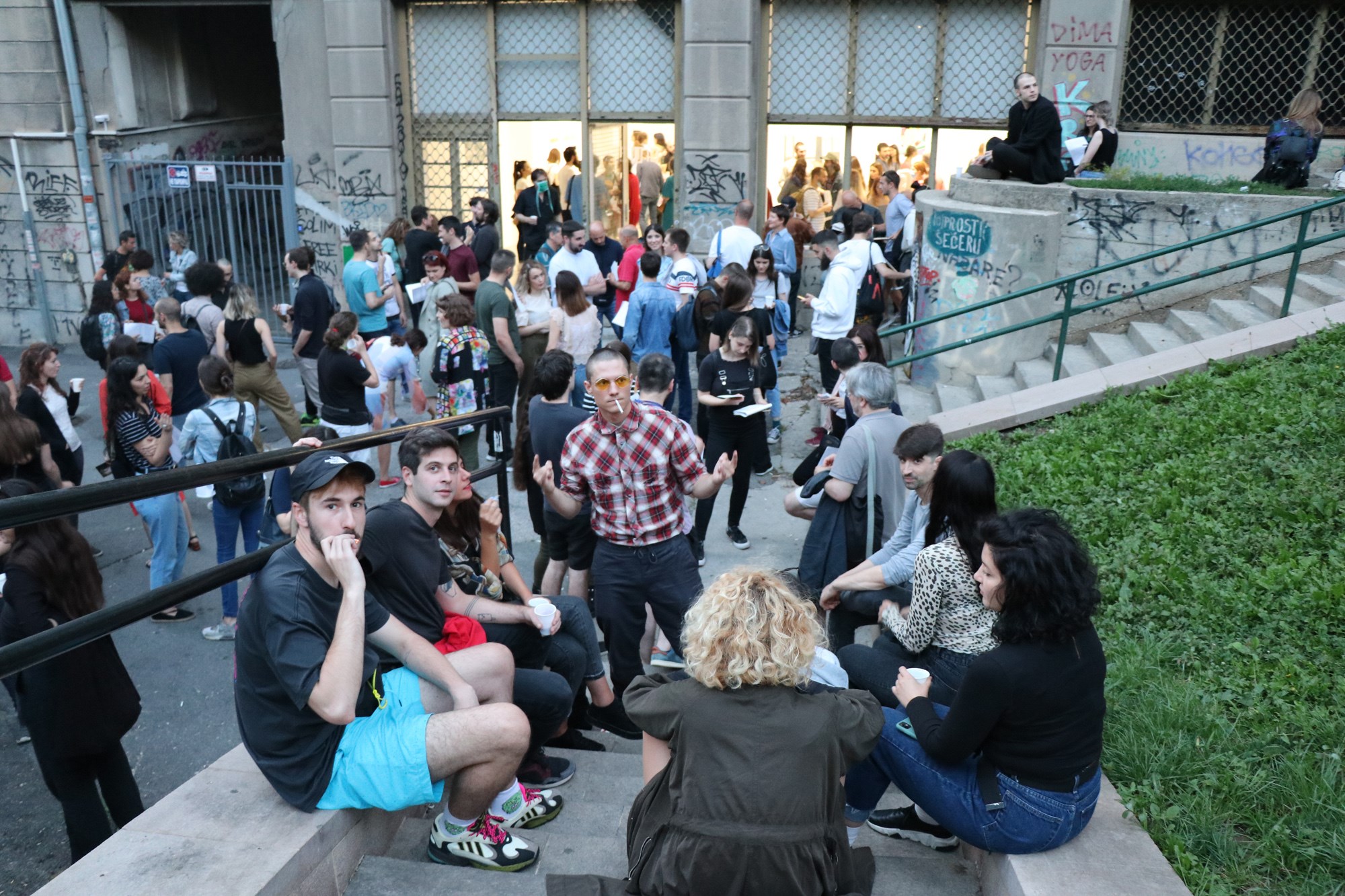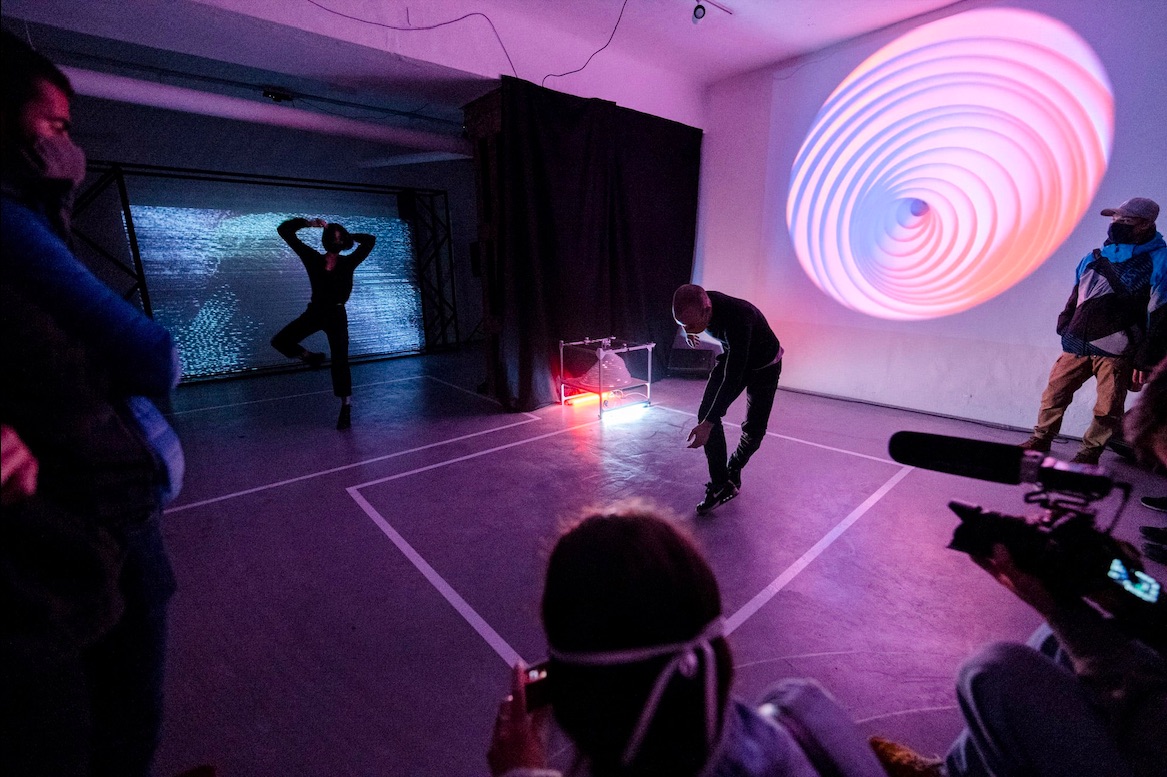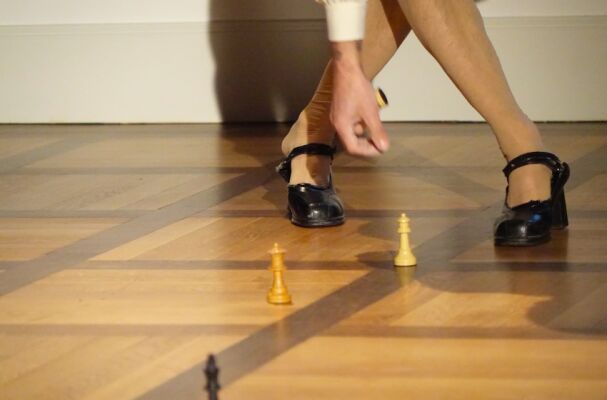Gold und Liebe V. – It’s about friendship and this sense of otherness
In the summer of 2020, we recorded a radio show with the participants of a regional cooperation project. We organised the cooperation together with the members of Budapest-based MŰTŐ group.
We received the grant of the International Visegrad Fund to make this idea a reality in 2019. The project – Alterum – artist-run network in the CEE region was launched last February with the aim of starting to build a horizontal network between four Central-Eastern-European artist-run cultural initiatives through joint trips, research and four group exhibitions. Artists-curators-researchers, members of U10 (Belgrade), 35M2 (Prague) and VUNU (Kosice) came to Budapest last Valentine’s Day, than right after the whole world turned around. We’ve been postponing trips and re-structuring ever since, trying to keep our connection and project going online. The conversation below is an excerpt from last year’s radio show on Lahmacun community radio – a self-interview or a simple conversation excerpt with the core crew of Alterum: Iva Kuzmanović, Darko Vukić (U10, Belgrade); Tea Záchová, Fekete František (35M2, Prague); Ivana Rusnáková, Nikolas Bernáth (VUNU, Kosice).
Ráhel Anna Molnár: Maybe we could start from the meaning of Alterum, ’the other’ and ’otherness’. Alterum actually grew out from a certain lack. As DIY cultural spaces we always give potential answers – this project is also one potential answer to the lack of instrastructure and closeness that would connect (semi-) peripheric localities of DIY culture. It’s about friendship and this sense of otherness. There is a beautiful concept in Hanna Arendt’s writing about friendship, as the company that one chooses to keep in the present as well as in the past. It’s a prcess of be-friending people, ideas and abstract or physical objects even. We’ve also been inside a process of befriending certain ideas of Eastern-Europe and Easterness. Could you all just summarize the position of your initiatives and also tell about your participation in our collaboration?
Iva Kuzmanović: U10 exists for eight years now. At the time, there was a huge gap between the spaces that were exhibiting students and then those for established artists. the Museum of Contemporary Art was closed for years, there was a lacking infrastructure. The space was cheap and really well located, so we just decided to do it. We started as a collective. We wanted to show the art of our own and also of those who we liked. It was supposed to be a short-term project back then. But it was obvious that such a platform that would show young and emerging artists was very much needed in Belgrade specifically. We were thinking pretty locally than. Eventually we had visitors from abroad, interested in what was going on in Serbia, especially related to the non-official, non-institutional art scene. We started to make beautiful and very potent relations and very soon we started to enjoy the fruits of this international communication; we experienced what it means to exchange experiences on this level.
We belong to the generations that grew up in pretty much hermetically closed environments. Although, that the situation related to the mobility of the citizens here changed already, back than it was literally dependent on the individual ability to achieve something, for example travelling. When we got invited to the project, we simply felt that the idea was sincere. I also feel differences there but it’s something that is actually a benefit of the communication not an obstacle. The idea was well articulated but there was also this true sincerity of the approach.

Tea Záchová: 35M2 was the first artist-run gallery in the Žižkov district. Then came Hunt Kastner, which is commercial, but after the millennium both were very important for the Czech artistic scene. It’s rare that a gallery like this exists for such a long time. People usually get exhausted after some time in the non-profit scene. Historically, Žižkov was really underground. There were gamblers, prostitutes, homlesses as well, red-bars. Its reputation changed a lot after the millennium.
František Fekete: Our initiative is based on collaboration with the youngest generation of artists. We organise mostly solo exhibitions and the artists always make a new project for the space. 35 square metre is the actual size of the space. Our activity is closely connected to Cafe Pavlac, located right next to us. Žižkov has been gentrified during the last couple of years but there are districts in the city which are worse in that sense. It’s also a gallery district and a lot of students and young people live here. Within the reach of just a few blocks there are around 10 galleries. Commercial ones, artist-run spaces and off spaces as well. The atmosphere is not that of competition, but rather cooperation.
Nikolas Bernáth: We started a project called Kotolňa, in a former high school in Kosice. It was a rough space without water or heating, a real warehouse. Later on, VUNU was in squat for one year, so came from this approach. Than eventually we found this space on the main street, where we are operating now. It’s nice, it’s cute, you know with wooden floors and everything. It’s something completely different to our previous practice.
Ivana Rusnáková: We felt that in Kosice and generally, in the Eastern part of Slovakia there was a gap between the institutionalised cultural spaces, museums and galleries and all the other, random spaces. 2020’s program was supposed to focus more on the international scene – we wanted to present some people from Germany, from Italy and Spain. The gallery program is the priority of what we do but we like to occupy unused spaces a lot to fill them with contemporary culture. As for the Alterum we are connected to the Budapest art scene and Prague as well, but we are not so much aware of Serbia, so it can really broaden our understanding of what’s going on. We say our contexts are similar, because of the notion of „Eastern-Europe”, but at the same time it’s very different. This is something we can also explore. The sense of friendship is there and it can be broadened.


Iva Kuzmanović: People are pretty oblivious about the thriving art scene of Kosice. How did it happen, why Kosice? Is there an explanation? Usually people know capitals of our countries. I mean come on, you have a Kunsthalle.
Nikolas Bernáth: Kosice has always been a cultural city. From the 60’s and 70’s there was a strong connection Prague and its the underground scene. We also have a huge modern tradition with Košická moderna – a movement especially in painting. Kosice was also multicultural – full of Jewish, German, Hungarian and Slovak people –, and this mix somehow became a good platform for cultural activities. The Faculty of Fine Arts came also came to the city and in 2013 it was the European Capital of Culture, so a lot of finance came from the European Union. The city built the infrastructure, so we have for example the Kunsthalle or Kasárne/Kulturpark. The non-physical infrastructure came with all of this, the students, exhibitions, discussions and so on. It was a huge explosion of culture in the city. But in reality, some of these buildings are empty, for example the Kunsthalle. There is no curator. If you want to do something there, you can, but on your own. The whole cultural scene is here and you can feel it, but maybe it seems better when you just see it from afar, the reality is a bit different.
Ivana Rusnáková: Still, as Nikolas mentioned, anybody can use it. I wouldn’t say that something is empty is necessarily a bad thing. It’s also an opportunity.
Nikolas Bernáth: Yes, if you’re active, you can do an exhibition in a crazy big space. It’s not really possible to do things like that in London or Berlin. If you want to use a space of 1000m2 you need to go through a lot of bureaucracy. Here in Kosice, you just say: Hey, I’d like to do this, what about July? And the answer is: Yeah, do it.
Iva Kuzmanović: It is a very useful opportunity for emerging artists and initiatives but it is also a very bold symptom of the carelessness of the state. You have all this infrastructure that is just left to rot. Buildings need maintenance, but without that you’re creating content in some decaying skeleton.

Nikolas Bernáth: You can do a lot of things, but you also need to realise that from some point it’s not going to be exclusively for contemporary art. You need to realise if a city in the periphery of the European Union and Slovakia, – such as Kosice – has these buildings, at some point it’s not possible to run a space that big just for contemporary art, culture, experimental things and all that. You will also have folklore there, or maybe some activities for seniors, pop culture or whatever.
Darko Vukić: Talking about Belgrade in this context, I think our situation was tremendously transitional from the end of the 90’s and beginning of 2000’s. A scope of ten years is enough for cultural policies to change almost completely. U10 also came at a point when young people didn’t have much space for themselves. There was the youth cultural center and so on, but none of those examples were totally focused on supporting emerging artists.
When U10 came into existence in 2012, it served as an example of the possibility of self-organisational platforms to exist in the future. In a few years some other spaces opened in Belgrade. People organised themselves and developed some other models of self-organised practices in the public art sphere. Kvaka 22 Cultural Center was the first successful example of squatting older buildings, that have some historical context and value.
We also needed those chances to get abroad, to reconnect with similar tendencies. I’m really into empowering people to realise that they’re having by themselves agencies and can become functionalities. By saying agencies, I mean some kind of navigations and orientations that we can use to plug different systems in to one another. That’s the only way I can envision the possibility of cohesive structures of collectivity. I think that is the most important. If what you do that does not include the interest of the other, it loses much of the sense of collaboration. Than it gets bureaucratical capitalistic context.
Tea Záchová: When you were developing the project, why did you choose mostly capital cities? I know you did research outside of Prague in more peripheric towns. I think sometimes it’s better to research the scene behind the border of the capital.Ráhel Anna Molnár: Honestly, in the beginning I didn’t have in mind that this project can grow this big. I was just searching for activities that I can relate to, I just reached out, we had conversations and we pretty much let it develop organically. I believe that no cooperation can develop in a sincere level unless you have some chemics working with your partners. Just the same way as we organise our communities locally. We didn’t really think about it conceptually for a very long time. It’s important though that I see Alterum as an open-boarder cooperation. The idea is that through research and time we include different localities, people and thoughts.
Darko Vukić: I’m sure that Serbia is not generally developed in that sense. Belgrade is definitely the most developed and central city. Besides that, there is only Novi Sad. Most of the examples of what we can offer in terms of the cultural scene are coming from Belgrade. That is something you can’t avoid. We have museums and institutions across the country, but there is no similar example as the one that you guys have in Kosice.

Ráhel Anna Molnár: Hungary is also centralised to Budapest, not only in terms of culture but in every aspect. There are some other cities with artistic higher education, so they have something going on in terms of the art scene.
Iva Kuzmanović: Why? It’s probably a complex matter, but can you tell in short why Hungary is so centralised?
Ráhel Anna Molnár: It has political reasons here.
Iva Kuzmanović: Yeah here as well.
Nikolas Bernáth: Yes, but Budapest is also a historical city. I think it is also because of the strong status of Budapest. In Slovakia, we have no example for that.
Ráhel Anna Molnár: Probably that’s the point why you have those other cultural activities not only in Kosice, but also in Zilina for example. In Czech Republic there is also Brno and Ostrava than maybe Ustí nad Labem, as other central spots in terms of contemporary culture. The whole history is different. In Hungary, there is no such balance, but it was not always the case. We had other cities. Now, we have villages.
Nikolas Bernáth: Budapest and “vidék”, right?
Ráhel Anna Molnár: Yes, we basically refer to all the other cities in the country as “vidék”.
Tea Záchova: Prague is focusing only on the high profit art scene. Everyone wants to be here, wants to exhibit here and establish a career but nobody really knows what is going on elsewhere in the country. I think the periphery of the Czech Republic is more interesting. The Prague scene is more selfish I would say, so I personally would choose another city for such a project. I studied in Ustí nad Labem, so I know how the relationship is working between the capital and the peripheries. I love Prague, but still it is like living in a bubble.
Ráhel Anna Molnár: Yes totally, but on the other hand, now that we are having this conversation with you, who are operating an art-space in Prague we can actually address these questions.
Darko Vukić: I don’t think Serbia has always been this centralised. My hometown, Ivanjica was the city where one of the first art colonies took shape in the ’60-s. It was amazing when I got to know this. A lot of students from the region and Belgrade came to the city and they did a lot of production. Now these works are stored some disastrous depo. It was a cultural center but it’s in a devastating state. And it wasn’t in that state back in the time when it functioned. Now, it’s so hard to imagine to be some kind of an enlightment figure in your own city and make people more aware of the necessity of believing what is possible. It could become a mission.
Ráhel Anna Molnár: In the beginning of 20th century there were many art colonies established in Hungary as well and later on it had a wave in the alternative scene under socialism from the 60’s. If you want to do a kind of socially engaged program now, you have to face a political reality where I have to say at some point you start to feel people are brainwashed. You have to have great powers to somehow break the wall that the current political ideology and rhetoric have built between the people in Hungary. The whole society is very divided by the populist political propaganda, and it divides geographically as well – talking about Budapest and “vidék”.
This article was created with the support of Summa Artium.





